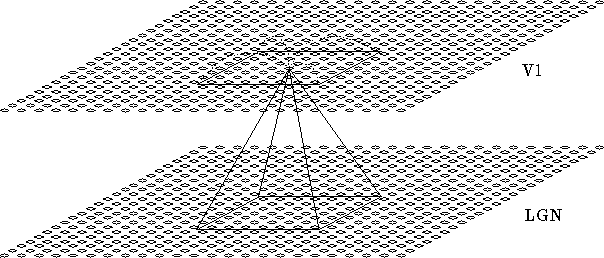


Next: Symmetry Breaking Columns
Up: Development of Orientation
Previous: Development of Orientation
A network of neurons which are assigned onto a 2-dimensional plane
represent the cells in lateral geniculate nucleus (LGN) which are the
inputs to the visual cortex and are not orientation selective. Another
group of neurons which are also assigned onto a 2-dimensional plane
represent the cells in visual cortex (V1) which receive feedforward
connections from LGN cells and also receive feedback connections from
other V1 cells. The network is illustrated in Figure 1.

Figure 1:
There are two types of connections for cortical cells: the feedforward
connections from input LGN cells (within the rectangle connected with solid
lines) and the massive feedback connections from V1 cells (within
the rectangle connected with dotted lines). Due to the massive feedback
among the participating cortical neurons, each cell acquires its response
via a collective computation.
Each V1 cell receives feedforward connections only from the LGN cells
within a specified area. Each V1 cell also receives feedback
connections from other V1 cells within a small area (the size does not
matter much as long as comparable to the size of the specified input
area). Initially, the strengthes of the connections are small random
numbers.
Natural images are used as the inputs to the network. The images are
first filtered with the known DOG (difference of Gaussian) kernel for
LGN.



Next: Symmetry Breaking Columns
Up: Development of Orientation
Previous: Development of Orientation



